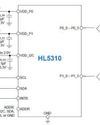
When working with microcontrollers and other digital systems, we don't usually have to be concerned about anything but ones and zeros, right? But sometimes our MCU has to connect to the real world, and that can be messy. Sometimes we have to use that algebra that we couldn't see the need for in high school to make sure that we get the inputs or outputs we want and do it without damaging anything in the process. And in some cases, mesh analysis is how we handle that. I want to show you a few simple mesh circuits, and how they may be calculated and applied in practical scenarios. If you went to EE school, you probably saw this material in a fundamentals of electrical engineering course.
SIMPLE MESH CIRCUIT
Figure 1 shows a simple mesh circuit of three resistors. For a review of resistors, see my article "Getting Started with Resistors" in Circuit Cellar issue 382. Let's say that we need to calculate the voltage across the 2K resistor R2. This is fairly simple to do using series/parallel resistor calculations. R2 is 2K, R3 is 3K, so the value of R2 and R3 in parallel is 1.2K.
The current through R1 plus the parallel combination of R2 and R3 is:
The voltage across the parallel combination of R2 and R3 is:
2.27ma x 1.2K = 2.73 v
So the current through R2 is 2.73V/2K = 1.36 ma.
This simple example illustrates some general principles of mesh circuits:
•The sum of the currents into a node (connection) is zero. The current flowing into the junction of R1, R2, and R3 has to equal the current flowing out. So the 2.27ma flowing in through R1 has to equal the two currents flowing out through R2 and R3. Note that in doing the calculations, you can (and usually do) assume that all currents are positive, flowing into the circuit. When you do the math, at least one will turn negative.
This story is from the {{IssueName}} edition of {{MagazineName}}.
Start your 7-day Magzter GOLD free trial to access thousands of curated premium stories, and 9,000+ magazines and newspapers.
Already a subscriber ? Sign In
This story is from the {{IssueName}} edition of {{MagazineName}}.
Start your 7-day Magzter GOLD free trial to access thousands of curated premium stories, and 9,000+ magazines and newspapers.
Already a subscriber? Sign In

Renesas New RA8 Entry-Line MCU Groups Brings High Performance of Arm Cortex-M85 Processor to Cost-Sensitive Applications with Market-Leading CoreMark Performance
Renesas Electronics Corp., a premier supplier of advanced semiconductor solutions, introduced the RA8E1 and RA8E2 microcontroller (MCU) groups, extending the industry's most powerful series of MCUs.

Same Sky Expands AMT Absolute Encoder Line to Support Larger Shaft Sizes
Same Sky's Motion & Control Group announced the addition of a new series to its innovative AMT absolute encoder family designed to support larger motor shaft sizes from 9mm to 15.875mm (5/8 inch).

XP Power Launches New Series of Low-Profile, Baseplate-Cooled DC-DC Brick Converters
The RDF150 and RDF200 series are the latest additions to the RDF series of low-profile, baseplate-cooled, ultra-wide input DC-DC brick converters, which is already available in power outputs of 25W and 50W.

HMI Introduces Ultra-Low Voltage 12-bit GPIO Expander with Interrupt Output
HMI, a leading provider of advanced analog and power management technologies, announced the launch of its HL5310, an innovative ultra-low voltage 12-bit GPIO expander featuring interrupt output.

The Future of Embedded Chip Design Navigating the Chip Creation Space
Custom Silicon at Lower Cost, Reduced Development Time

The Long and Winding Road
From Maxim's RS-232 to WeMos ESP32: So Much to Do, So Little Time

Start to Finish Driving LCDs
Lumex Display with Microchip Driver for a TI MCU

Easing the Path for App Releases
Managed Development of React Native with Expo

Datasheet: Tiny Embedded Boards
Deliver Power, Performance, and Versatility in Meager Square Millimeters

Harvesting Ambient Energy
Hybrid Power Sources Cut IoT Battery Dependency